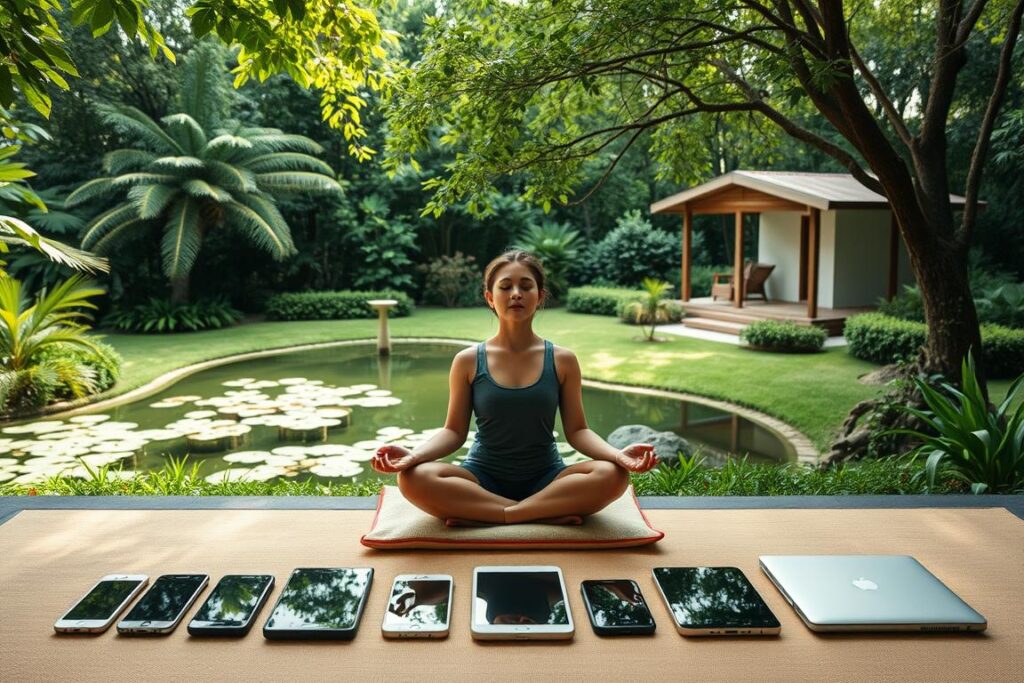Digital detox: how 24 hours without a screen can change your life
Did you know that, according to a study by the University of Bochum, 80% of Germans say they spend more time in front of a screen than they would like? Technology detox, also known as digital detox, is a growing movement that encourages people to consciously give up digital devices. A 24-hour digital detox can have amazingly transformative effects on your wellbeing and raise your awareness of your technology use.
In this article, we explore how a 24-hour screen break can significantly improve your quality of life. We look at the psychological and physical benefits of such a digital break, the long-term effects on your everyday life and offer practical tips on how to implement it.
Join us on this journey to a healthier, more balanced digital life and discover how just one day without a screen can lead to more peace and balance.
What is a digital detox?
A digital detox is a conscious digital break from screens and digital devices. This break serves to reduce dependence on technology and increase general well-being.
Definition and meaning
The digital detox definition refers to the voluntary renunciation of digital devices and applications for a certain period of time. The aim is to reduce the cognitive and emotional stress caused by constant accessibility and to promote personal health.
Different forms of digital detox
There are various forms of digital detox that can be adapted to suit individual needs. Some opt for a complete digital time-out, while others prefer targeted breaks from individual applications such as social media, emails or instant messaging. These diverse approaches help to tailor the benefits of a digital detox to personal needs.
Why is a digital detox necessary?
In today’s digital world, it is unavoidable to disconnect from technology from time to time. Online abstinence, i.e. consciously refraining from using digital devices, can have numerous positive effects on our well-being. Digital overload and constant availability can be both psychologically and physiologically stressful.
Psychological effects of constant accessibility
Constant availability can lead to considerable psychological stress. This includes stress and sleep disorders in particular. People who are constantly looking at their smartphone or laptop run the risk of feeling under constant pressure. Another effect of digital overload is the difficulty in relaxing and really switching off. This psychological strain is one of the most obvious effects of technology in everyday life.
Physiological effects of excessive screen use
Excessive screen use also has physiological effects. Frequent problems include neck and back pain as well as eye problems due to prolonged screen work. Furthermore, the ability to concentrate can be reduced by the constant use of digital devices. Regular time spent online can remedy this and help to reduce these negative effects of technology.
Signs that you need a digital time-out
Recognizing digital exhaustion is crucial to taking timely action to slow down digitally. There are several warning signs that can indicate that you need a break from the screen. The most common signs include:
- Excessive media consumption: If you spend a lot of time in front of screens and feel like you can’t switch off, this could be a sign that a digital time-out is needed.
- Neglecting personal relationships: Have you noticed that you’re spending less time with family and friends because you’re constantly online? This is an important sign of digital exhaustion.
- Physical symptoms: Fatigue, headaches and eye strain are often physical indicators of overuse of digital devices.
- Persistent distraction: Do you find it difficult to concentrate on tasks without constantly looking at your smartphone or tablet? This can also be a warning sign.
- Sleep disorders: Difficulty falling asleep or disturbed sleep may indicate digital overload caused by excessive screen time.
Advantages of a 24-hour digital detox
A 24-hour digital detox offers numerous opportunities that can improve quality of life and general well-being. By staying away from screens and digital media, various positive effects can be achieved.
Improved ability to concentrate
Without digital distractions, the ability to focus on important tasks increases. This consciously chosen retreat offers the benefits of screen time and has a direct impact on efficiency and productivity.
Less stress and more relaxation
Avoidable stress levels can be reduced enormously by consciously avoiding digital media. The reduced sensory overload promotes stress reduction and leads to a generally relaxed state.
Better quality of sleep
Avoiding screens also promotes improved sleep quality. By reducing the blue light from digital devices, melatonin production is less disturbed, which contributes to restful sleep and thus supports improved quality of life.
More time for personal interests and social interactions
Another benefit of the digital detox is the time regained for personal interests and social interactions. Without the distraction of screens, you can focus on real conversations, hobbies and other activities that are otherwise often neglected.
How do you prepare for a digital detox?
Successful preparation for a digital detox starts with planning a digital break. First of all, clear goals should be set to ensure the success of the project. Questions such as “Why do I need this digital break?” and “What positive changes do I expect?” help to mentally prepare for the challenges ahead. These objectives are essential to maintain motivation during the detox.
Another important step is to inform your social environment. Family, friends and colleagues should be informed that you will not be using electronic means of communication for a certain period of time. This will prevent misunderstandings and ensure that urgently needed communication can take place in the traditional way.
It is also advisable to plan alternative activities to digital activities in advance. Whether it’s reading a book, going for a walk or pursuing a hobby – planning a digital break is made much easier if attractive alternatives are available. This keeps everyday life varied and minimizes the temptation to return to digital devices.
When preparing for a digital detox, the workplace should not be forgotten either. Clear instructions and, if necessary, the delegation of certain tasks ensure that the digital detox runs professionally and smoothly. Thorough preparation and well thought-out planning are the keys to a successful digital time-out.
Strategies for a successful 24-hour digital detox
Going 24 hours without a digital companion can be a challenge, but with the right strategy, it can be a positive and rewarding experience. Here are some proven digital detox strategies to ensure a successful technology detox:
Detailed planning and objectives
To successfully implement digital fasting, it is important to plan in advance. Define clear goals as to why you want to take a digital time-out and set a fixed time period. Prepare a list of activities that you would like to do during this time to make the day meaningful.
Informing and involving the environment
Communicate your plans with friends, family and work colleagues. Inform them about the reasons and the period of your time away so that they understand and respect your absence. This will help to avoid misunderstandings and support you in implementing your plans.

Replacing digital activities with analog alternatives
A successful technology detox also involves finding and using analog alternatives for otherwise digital activities. For example, instead of social media you could read a book, instead of watching a series you could go for walks in nature or start a creative project. Such activities will help you to reduce the urge to use digital devices while keeping your day productive.
Activities you can do during a digital detox
A digital detox is the perfect opportunity to reduce screen time and immerse yourself in screen-free activities. Here are some suggestions for your electronics-free time:
Go for a walk: A walk in nature is one of the best screen-free activities. Whether in the park, in the forest or on the beach – the fresh air and natural surroundings help to clear your head and relieve stress.
Yoga: Yoga is not only good for the body, but also for the mind. It helps you to relax and consciously experience the moment. A regular yoga practice can also increase your ability to concentrate.
Art projects: Painting, drawing or crafting are great activities to be creative while staying away from digital devices. It doesn’t matter whether you are an experienced artist or just enjoy experimenting.
Discover new places: Use your electronics-free time to explore new places without digital distractions. Visit local sights, interesting museums or experience new hiking trails. There are countless ways to discover the world offline.
These screen-free activities can help you take full advantage of a digital detox and gain new experiences at the same time. No matter which activity you choose, the main thing is to consciously enjoy the time and fully engage in e-free time.
Experiences and reports from people who have done a digital detox
More and more people are discovering the benefits of digital detox and sharing their positive experiences. These Digital Detox testimonials show how consciously giving up digital media can make a lasting difference to your life. The following reports show not only short-term effects, but also long-term benefits for overall well-being.
Positive changes and insights
Numerous reports testify to a significant increase in productivity and an improvement in interpersonal relationships. Many people report that after a digital detox they are more conscious of how they spend their time and have developed a greater awareness of their media consumption. The newfound peace and quiet and time for themselves is often cited as one of the biggest benefits.
“After my digital detox, I feel much more relaxed and focused. It has improved my relationships and made me realize how dependent I was on my smartphone.” – Maria Müller
Long-term effects on life
The long-term benefits of a digital detox cannot be denied. Many participants report a lasting change in their digital habits. Conscious media consumption contributes to a balanced life in which stress is reduced and mental health is promoted. These long-term benefits show how important it is to regularly schedule a digital time-out.
Finding a long-term digital balance
After a successful digital detox, the question arises as to how a lasting media balance can be integrated into everyday life. To achieve this, regular digital breaks are essential. Consciously taking breaks during screen time allows you to relax your eyes and keep your focus.
“Successful digital balance means having control over your own technology use and not the other way around.”
Another important factor is the use of technology blocks. These can include time-limited blocks for certain apps or websites to minimize distractions. Many smartphones now offer integrated functions for this.
It is also helpful to be aware of your own screen time. Various apps and tools make it easy to track how many hours a day are spent in front of a screen. This insight makes it possible to take measures to reduce and better distribute media use.
- Take regular digital breaks
- Use of technology blocks
- Awareness of your own screen time
These strategies can be used to achieve a lasting media balance that leads to a healthier digital life in the long term.
Helpful tools and apps for a healthy digital life
In the modern world where we are constantly surrounded by screens, it is essential to find media usage tools that help us lead a healthy digital life. Various apps for digital detox make it possible to monitor and reduce screen time. For example, many smartphones already offer built-in digital wellbeing features that provide insights into daily app usage and can set usage time limits.
Specially developed apps such as Forest or Freedom go one step further by blocking access to certain websites and applications to increase focus and productivity. In addition, media usage tools can help people to develop a better awareness of their own consumer behavior and promote healthier habits.
“Using apps for Digital Detox has helped me to significantly reduce my screen time and improve my ability to concentrate.” – Anonymous user
In addition to such apps, there are also media usage tools such as browser extensions or desktop programs that help to manage and control screen time. These tools offer different functions, from time management and user reports to reminders to take a break. By combining these approaches, we can not only make better use of our time, but also improve our overall wellbeing and find a healthy balance in our digital lives.
The digital detox trend: how widespread is digital fasting?
In recent years, the digital detox trend has gained considerable popularity. More and more people are recognizing the need to take digital breaks from their screens to improve mental and physical wellbeing. Numerous surveys and studies show that the prevalence of technology detox is steadily increasing as more and more people and institutions become aware of the negative effects of excessive screen use.
Another key driver of the digital detox trend is the incorporation of this practice into wellness programs and retreats worldwide. Many wellness hotels and resorts are offering special digital detox packages that aim to provide their guests with a complete digital time-out. This development underlines the growing awareness and willingness to temporarily switch off digital media in order to find inner peace and relaxation.
This growing interest can also be observed in Germany. Many people are consciously taking time out from digital devices and reporting positive experiences and improvements in their everyday lives. Given the increasingly digitalized world, the spread of technology detox as a means of promoting a balanced lifestyle and reducing stress is crucial. Industry experts predict that the digital detox trend will continue to spread as general awareness of the associated benefits grows.


